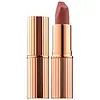What's inside
What's inside
 Key Ingredients
Key Ingredients

 Benefits
Benefits

 Concerns
Concerns

 Ingredients Side-by-side
Ingredients Side-by-side

Isododecane
EmollientSynthetic Wax
AbrasivePolybutene
Trimethylsiloxysilicate
EmollientSucrose Tetrastearate Triacetate
EmollientIsoamyl Laurate
EmollientSilica
AbrasiveHydrogenated Jojoba Oil
AbrasiveCetearyl Behenate
EmollientSynthetic Fluorphlogopite
Pentaerythrityl Tetra-Di-T-Butyl Hydroxyhydrocinnamate
AntioxidantEthylhexyl Palmitate
EmollientKaolin
AbrasiveTrihydroxystearin
Skin ConditioningSodium Hyaluronate
HumectantColophonium
CI 77491
Cosmetic ColorantCI 77492
Cosmetic ColorantCI 77499
Cosmetic ColorantCI 77891
Cosmetic ColorantMica
Cosmetic ColorantCI 77742
Cosmetic ColorantCI 19140
Cosmetic ColorantCI 15850
Cosmetic ColorantCI 42090
Cosmetic ColorantCI 15985
Cosmetic ColorantCI 45410
Cosmetic ColorantCI 77163
Cosmetic ColorantIsododecane, Synthetic Wax, Polybutene, Trimethylsiloxysilicate, Sucrose Tetrastearate Triacetate, Isoamyl Laurate, Silica, Hydrogenated Jojoba Oil, Cetearyl Behenate, Synthetic Fluorphlogopite, Pentaerythrityl Tetra-Di-T-Butyl Hydroxyhydrocinnamate, Ethylhexyl Palmitate, Kaolin, Trihydroxystearin, Sodium Hyaluronate, Colophonium, CI 77491, CI 77492, CI 77499, CI 77891, Mica, CI 77742, CI 19140, CI 15850, CI 42090, CI 15985, CI 45410, CI 77163
Neopentyl Glycol Dicaprylate/Dicaprate
EmollientTrimethylolpropane Triisostearate
EmollientDimethicone
EmollientCera Microcristallina
Emulsion StabilisingPolyethylene
AbrasivePolybutene
Dimethicone Crosspolymer
Emulsion StabilisingSilica
AbrasiveDicalcium Phosphate
AbrasiveEthyl Vanillin
MaskingCaprylic/Capric Triglyceride
MaskingTocopherol
AntioxidantCarthamus Tinctorius Seed Oil
MaskingZea Mays Oil
EmulsifyingPentaerythrityl Tetra-Di-T-Butyl Hydroxyhydrocinnamate
AntioxidantCarica Papaya Fruit Extract
Skin ConditioningOrchis Mascula Flower Extract
SoothingBixa Orellana Seed Extract
MaskingBHT
AntioxidantTocopheryl Acetate
AntioxidantTin Oxide
AbrasiveMica
Cosmetic ColorantCI 77891
Cosmetic ColorantIron Oxides
CI 45410
Cosmetic ColorantCI 15850
Cosmetic ColorantCI 42090
Cosmetic ColorantCI 15985
Cosmetic ColorantCI 19140
Cosmetic ColorantCI 75470
Cosmetic ColorantNeopentyl Glycol Dicaprylate/Dicaprate, Trimethylolpropane Triisostearate, Dimethicone, Cera Microcristallina, Polyethylene, Polybutene, Dimethicone Crosspolymer, Silica, Dicalcium Phosphate, Ethyl Vanillin, Caprylic/Capric Triglyceride, Tocopherol, Carthamus Tinctorius Seed Oil, Zea Mays Oil, Pentaerythrityl Tetra-Di-T-Butyl Hydroxyhydrocinnamate, Carica Papaya Fruit Extract, Orchis Mascula Flower Extract, Bixa Orellana Seed Extract, BHT, Tocopheryl Acetate, Tin Oxide, Mica, CI 77891, Iron Oxides, CI 45410, CI 15850, CI 42090, CI 15985, CI 19140, CI 75470
 Reviews
Reviews

Ingredients Explained
These ingredients are found in both products.
Ingredients higher up in an ingredient list are typically present in a larger amount.
Ci 15850 is the pigment color red. It is an azo dye and created synthetically.
Azo dyes need to be thoroughly purified before use. This allows them to be more stable and longer-lasting.
This ingredient is common in foundations, lipsticks, and blushes. This color is described as brown/orangey red.
It has many secondary names such as Red 6 and Red 7. According to a manufacturer, Red 6 usually contains aluminum.
Learn more about CI 15850Ci 15985 is a dye made from petroleum. It is synthetically created and approved by the FDA for use in foods and cosmetics.
The color of this dye is orange/yellow.
This ingredient can be found in makeup, sun care, and skincare.
Learn more about CI 15985CI 19140 is also known as Tartrazine. Tartrazine is a synthetic dye used in cosmetics, foods, and medicine to add a yellow color.
Tartrazine is created from petroleum and is water-soluble.
Some people may experience allergies from this dye, especially asthmatics and those with an aspirin intolerance.
Learn more about CI 19140Ci 42090 is a synthetic dye created from petroleum. It is used to give a bright blue color to cosmetics, medicine, and food.
CI 45410 is a synthetic red-pigment and dye.
It often goes by both Red 28 or Red 27; manufacturers label both ingredients as CI 45410.
This dye is commonly found in makeup because it imparts a vivid color. Some types of this dye change color based on pH level and interaction with moisture:
Your skin has a natural pH of around 4.5 - 5.5.
According to the FDA, CI 45410 is not permitted for use in eye products.
Red 27 is a flourescein dye and commonly used as a fluorescent tracer in medicine.
Learn more about CI 45410Ci 77891 is a white pigment from Titanium dioxide. It is naturally found in minerals such as rutile and ilmenite.
It's main function is to add a white color to cosmetics. It can also be mixed with other colors to create different shades.
Ci 77891 is commonly found in sunscreens due to its ability to block UV rays.
Learn more about CI 77891Mica is a naturally occurring mineral used to add shimmer and color in cosmetics. It can also help improve the texture of a product or give it an opaque, white/silver color.
Serecite is the name for very fine but ragged grains of mica.
This ingredient is often coated with metal oxides like titanium dioxide. Trace amounts of heavy metals may be found in mica, but these metals are not harmful in our personal products.
Mica has been used since prehistoric times throughout the world. Ancient Egyptian, Indian, Greek, Roman, Aztec, and Chinese civilizations have used mica.
Learn more about MicaPentaerythrityl Tetra-Di-T-Butyl Hydroxyhydrocinnamate (long name, huh?) is a synthetic antioxidant.
It is used to help stabilize other antioxidants or prevent the color from changing in a product.
As an antioxidant, it helps fight free-radical molecules. Free-radical molecules are capable of damaging our cells and other genetic material. Thus, antioxidants may reduce the signs of aging.
This ingredient is oil-soluble.
Learn more about Pentaerythrityl Tetra-Di-T-Butyl HydroxyhydrocinnamatePolybutene is used to help control the viscosity of a product. This just means it helps adjusts the texture.
It is a polymer and does not get absorbed into the skin due to its large size.
Studies found this ingredient did not irritate skin in concentrations below 15%.
Learn more about PolybuteneSilica, also known as silicon dioxide, is a naturally occurring mineral. It is used as a fine, spherical, and porous powder in cosmetics.
Though it has exfoliant properties, the function of silica varies depending on the product.
The unique structure of silica enhances the spreadability and adds smoothness, making it a great texture enhancer.
It is also used as an active carrier, emulsifier, and mattifier due to its ability to absorb excess oil.
In some products, tiny microneedles called spicules are made from silica or hydrolyzed sponge. When you rub them in, they lightly polish away dead skin layers and enhance the penetration of active ingredients.
Learn more about Silica